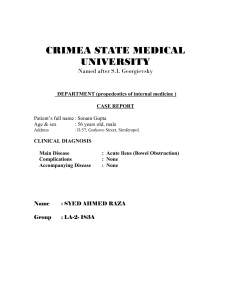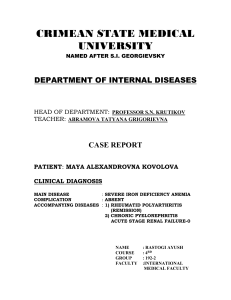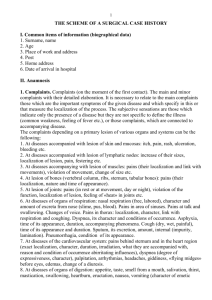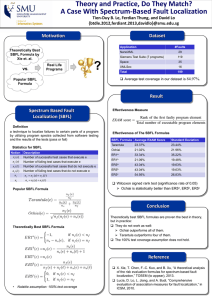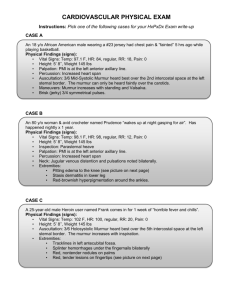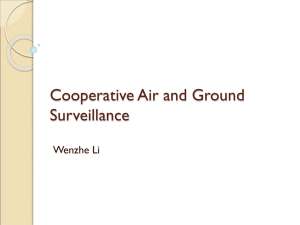Metoduchka_istorija_xvorobu_III_kyrs
advertisement
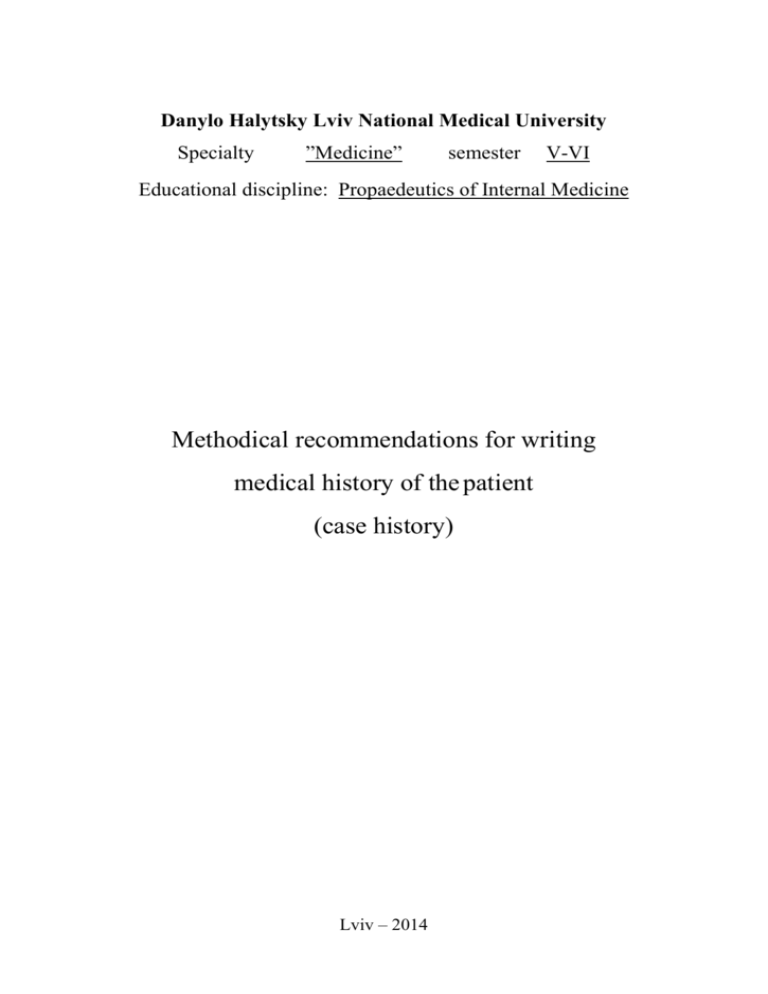
Danylo Halytsky Lviv National Medical University Specialty ”Medicine” semester V-VI Educational discipline: Propaedeutics of Internal Medicine Methodical recommendations for writing medical history of the patient (case history) Lviv – 2014 PASSPORT PROFILE. a) Basic information: first name, surname, title, address, post code, telephone number, admitted to the Clinic of Internal Medicine of Motol Teaching Hospital on (date)…. at (hour, min.) b) Cause of admission: brief accurate information on the reason for admission (e.g. protracted retrosternal pain accompanied by dyspnoea). c) In repeated hospitalisations, the date of the last hospitalisation. COMPLAINTS (Describe complaints, which disturbed patient at the 1 -st day of examination by student). Complaints preceding hospital admission, their origin, circumstances and development, must first indicate the main complaints (specific) for the disease with which the patient is treated in a hospital than nonspecific. ANAMNESIS MORBI - HISTORY OF ILLNESS (Describe all details bearing directly on the complaints: chronological account of the symptoms, investigations in the past and their results, treatment in the past and its efficiency). ANAMNESIS VITAE – PERSONAL HISTORY FH - Family History a) If father and mother are still living , they died, their age at death and their last diagnosis/cause of death. b) Brothers, sisters, children. c) Ask targeted questions concerning the familial occurrence of the following diseases: coronary heart disease (CHD), myocardial infarction (MI), cerebrovascular accident (CVA) – ipresence of or death due to vascular disease before 50 years of age in men and 55 in women is significant from epidemiological viewpoint, hypertension, diabetes mellitus (DM), neoplastic disease, tuberculosis, infectious hepatitis, neurological or psychiatric dieases. SH - Social History: a) Marital status - married, divorced, lives alone, etc. b) Accommodation arrangements - which floor, elevator, up the hill, etc. c) Occupation - physically demanding, stress, pollutants, risk at workplace, etc. d) Retired - old age pensioner, disabled, reason for the disability pension, since when. PA - Pharmacological Anamnesis: List of permanently taken medications including their dosing. AA - Allergic Anamnesis a) Drug allergy – kind and type of allergic reaction (exanthema, allergic oedema, anaphylactic shock), when the reaction occurred. b) Hay fever (pollinosis), allergy to dust, pollen, mites. c) Food allergy. 2 d) Allergy to adhesive plaster etc. e) Allergy to contrast media. GA - Gynaecological Anamnesis a) Menstruation – from - to, regular, irregular, date of the latest menstruation. b) Menopause - at what age, hormone replacement therapy. c) Number of children, number of spontaneous miscarriages or abortions. d) Gynaecological surgeries. e) Hormone contraceptives. EH – Epidemiologic History a) Chronological list of illnesses from childhood up to present date (dates to be given either in the form of the year or the age of the patient – should not be mixed, definitely not in the form of how many years ago) b) Children's infectious diseases (rubella, mumps, chicken-pox, scarlet fever, diphtheria), repeated tonsillitis, rheumatic fever (protracted febrile disease in childhood accompanied with joint swelling, or resulting in heart murmur). PH - Personal History a) Operations. b) Habits: smokes from - to, how many cigarettes a day, how long, date of giving up. alcohol – beer, wine, spirits, how much per day on average, regularity of consumption coffee – how many cups per day other habits. c) Ask about diseases of all body systems such as coronary heart disease (CHD) chest pain myocardial infarction orcerebral stroke in the past. Treated for hypertension – for how long, what type of treatment. d) Diabetes mellitus (DM) Type 1or 2 , what type of treatment, other metabolic and endocrine diseases (thyreopathy etc.). e) Digestive disorders - i.e. gastroduodenal ulcer, gallbladder problems, cholecystolithiasis, biliary colic, icterus, infectious hepatitis, intestinal problems – diarrhoea, obstipation, body weight stable, unstable, weight gain or loss (how many kilograms and in what time course), reason – anorexia, bad eating habits, vomiting, slimming diet, stress etc. Stools regular, irregular, pathological substances in the faeces – blood, mucus, melena. f) Urological problems - dysuria, pollakisuria, cystolithiasis, renal colic, haematuria. g) Diseases of lower extremities: – claudication, venous – varicose veins, state after deep vein thrombosis, chronic venous insufficiency, varicosel ulcer, joint problems, state after injuries, fractures. h) Briefly neurological diseases. REVIEW OF SYSTEMS (day of disease). 1. The general condition of the patient (satisfactory, moderate, severe, very severe, terminal (agonal). 3 2. Consciousness (clear, blighted, confused, fainting, stupor, sopor, coma, delirium). In the absence of consciousness assess its degree. 3. Position in bed (active, passive, forced - on which side, on the back, on the abdomen, immovable, restless, orthopnea). 4. Constitution (constitutional type) (asthenic, normostenic, hypersthenic). 5. Weight (kg) 6. Height (cm) 7. Skin a) color and its disorders (pallor, icteric, dermahemia (skin hyperemia), marbling, cyanosis); a) elasticity (elastic, inelastic, decrease in elasticity); b) humidity (increased humidity (sweating), dry skin); c) presence of pathological changes: rashes, hemorrhage, pigmentation (number, sizes, localization), itching, scars, vascular stars. 8. Conjunctivas: (pale pink, pallor, icteric) 9. Subcutaneous tissue a) general development - insufficient (extreme manifestation is cachexia), moderate, excessive (extreme manifestation is obesity); b) the distribution of subcutaneous fat layer. 10.Edema ( no), pastosity ( no) a) If we see presence of edema or pastosity we indicate their localization (lower limbs, back, face, anasarca), prevalence, texture. 11.Neck vessels (no visible changes, pulsation of the arteries, swelling of veins, pulsation of the veins) 12.Lymph nodes (not palpable, palpable) a) If palpable we indicate: localization (occipital, parotid, submandibular, front and lateral neck, supraclavicular, subclavian, axillary, elbow, inguinal, popliteal), size, form, consistency, painfulness, mobility, cohesion of the surrounding tissues, skin and each other, condition of the skin over them. 13.Thyroid gland (not palpable, palpable) a) If palpable we indicate: size (not enlarged, enlarge), consistence (soft, dense), pain (painless, painful) I. Respiratory system 1. Breathing through the nose (free, difficult – as a result of) 2. Number of breaths per minute 3. Breath depth (superficial, deep), 4. Breath rhythm (rhythmic, arrhythmic, breathing Biota, Cheyne-Stokes) 4 5. Type of breathing (thoracic, abdominal, mixed) 6. Shape of the chest: a) normal form (with description of attributes that correspond normostenic, asthenic or hypersthenic types) b) abnormal (emphysematous, rachitic, "chicken", funnel, etc), c) the symmetry of the two halves of the chest (symmetrical, asymmetrical) 7. Palpation of the chest. a) painless, painful (If palpable is pain we indicate in what parts of the chest there is pain, along the ribs and intercostal spaces, expansion and bulging intercostal spaces). b) the elasticity of the chest (elastic, inelastic) 8. Percussion sound (clear lung, tympanic, short, blunt), indicating localization. 9. Topographic percussion: Lower borders o f the lungs in normosthenic persons. Topographic lines Right lung Left lung Parasternal Midclavicular Anterior axillary Midaxillary Posterior axillary Scapular Paraspinal 5th interspace 6th interspace 7th interspace 8th interspace 9th interspace 10th interspace Spinous process of T II 7 th interspace 8 th interspace 9 th interspace 10 th interspace Spinous process of T II Respiratory excursion o f the lower border o f normal lungs in cm. Topographic Right lung Left lung lines Inspiration Expiration Total Inspiration Expiration Midclavicular 2-3 2-3 4-6 Midaxillary 3-4 3-4 3-4 3-4 6-8 Scapular 2-3 2-3 2-3 2-3 4-6 Total 6-8 4-6 10. Auscultation: vesicular breathing, hard breathing, weakened, strengthened, puerile, bronchial breathing (amforyc, metal). The weakening or absence of respiratory noise, indicate localization. 11. Breath sounds: not auscultated. If auscultated additional respiratory sounds then specify the following: a) Dry rales (whistling, squeaking, buzzing, humming) indicate localization. b) Moist rales (small, medium, large bubble), their sonority, place of hearing; crackling (indicate localization). c) Pleural rub, indicat localization. 5 d) Bronhofoniya (weakened, the same on both sides, reinforced). II. Cardiovascular system. 1. Apex beat: in 5th intercostal space by 1 cm to the middle on the left midclavicular line. 2. Pulse rate per minute a) rhythm (rhythmic, arrhythmic, which arrhythmia), b) tension (hard, soft, medium); c) filling. 3. Blood pressure mm Hg (left hand, right hand) 4. Border of relative cardiac dullness: a) Right - 1 cm from the right edge of the sternum in the 4th intercostal space b) Left – 1 cm medially from the left mid-clavicular line in the 5th intercostal space c) Upper – lower edge of the 3rd rib 5. Border of absolute cardiac dullness: a) Right - left edge of the sternum in 4th intercostal space b) Left – coincides with the relative cardiac dullness c) Upper - lower edge of the 4th rib 6. Auscultation: Tones (heart sounds) their sonority, at all points of auscultation (sonorous, rhythmic) In the case of pathological changes should indicate: a) Accents, splitting, split tones, additional tones (rhythm "gallop" rhythm "quail"), auscultatory phenomena. b) Murmurs their relation to the phases of cardiac activity, localization, maximum intensity, conductivity, character, strength, timbre duration. Changes depending on the phase noise of breathing, position the patient load. c) Pericardial friction, its location, duration. III. Digestive system 1. Oral cavity (needs sanitation, sanation not require) 2. Tongue: a) color (red, pale, cyanotic, crimson, black, lacquered) b) humidity (wet, dry) c) presence of plaque, ulcers, fractures, tooth prints 3. Inspection abdomen: a) size (increased, not increased) b) form (oval, "frog", involved, fallen, flaccid) 4. Palpation (not painful, painful during the palpation) 5. Percussion: a) percussion sound (tympanic, dull – indicate where) b) fluctuation symptom (present, not present) 6. Auscultation: peristaltic sounds (auscultated, does not auscultated) 7. Liver dimensions by Kurlov (indicate dimensions - 9×8×7 cm) 6 a) by the right midclavicular line – 7 cm b) by the median line – 8 cm c) by the left costal arch – 9 cm 8. The lower edge of the liver (does not appears from the costal arch, appears out of the costal arch on __ cm) 9. Spleen (indicate dimensions - 3×4 cm) 10.Gall bladder (not palpable, area of palpation not painful) 11.Pancreas (not palpable, area of palpation not painful) 12.Bowel movements ________day. IV. Urinary system 1. Area of kidney a) swelling (no, yes) b) congestion (no, yes) 2. Palpation of the kidneys (not palpable, palpable – specify size, density, elasticity, soreness, mobility) 3. Pasternatsky symptom (negative, positive – on the left side, on the right side, on both sides) 4. Edema ( no), pastosity ( no) a) If we see presence of edema or pastosity we indicate their localization (lower limbs, back, face, anasarca), prevalence, texture. 5. Dysuric signs (no, yes) 6. Daily diuresis __liters per day (1,5 – 2) V. Osteoarticular system 1. The joints a) swollen (no, yes - indicat localization) b) painful (no, yes - indicat localization) c) deformed (no, yes - indicat localization) 2. Range of movements (full, limited – indicat localization) PREVIOUS DIAGNOSIS On the basis of the received information (Complaints, Anamnesis morbid – history of the illnes, Anamnesis vitae – personal history, Review of system) form a previous diagnosis. PLAN OF EXAMINATION Basic tests that are performed always: a) complete blood count b) urinalysis c) blood chemistry (must specify the indicators you want to define) d) ECG e) stool for ova and parasites 7 Then specify additional tests to confirm the diagnosis and indicate necessary expert advice. Specify the parameters that you must define in analysis, and changes which you can expect TREATMENT PLAN a) Regime (stringent bed, expanded bed, ward semi bed, free) b) Dietary table №1, 1а,1в – peptic ulcer, chronic gastritis with increased secretion №2 – chronic gastritis with decreased secretion №3 – constipation №4,4а, 4в,4с,4d – bowel disease №5, 5а – liver disease №5p – diseases of the pancreas №6 – gout, urine acid diathesis №7,7а,7в – kidney disease №8 – obesity №9, 9а,9в – diabetes №10, 10а,10с,10і – diseases of cardiovascular system №11 – tuberculosis of the lungs and bones №12 – diseases of the central nervous №13 – acute infections №15 – common table c) Drug treatment DAILY CUMULATIVE REPORT (This is a short description of the patient condition that doctor conducts every day during his treatment). Indicate the date of examination. General condition of the patient. Number of breaths per minute, breath rhythm, percussion sound of the lungs, auscultation of the lungs. Apex beat, pulse rate per minute, blood pressure mm Hg (left hand, right hand), auscultation of heart: tones (heart sounds). Oral cavity, palpation of abdomen, the lower edge of the liver, bowel movements ______ day. Pasternatsky symptom, edemas, daily diuresis __liters per day. Approved at the department meeting Propaedeutics of Internal Medicine №1 “ “ of ____________ 20___ year Head of the chair ______________ Prof. MD Dutka R.J. 8
